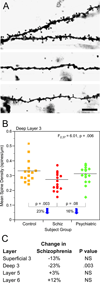Dendritic spine pathology in schizophrenia
- PMID: 22546337
- PMCID: PMC3413758
- DOI: 10.1016/j.neuroscience.2012.04.044
Dendritic spine pathology in schizophrenia
Abstract
Schizophrenia is a neurodevelopmental disorder whose clinical features include impairments in perception, cognition and motivation. These impairments reflect alterations in neuronal circuitry within and across multiple brain regions that are due, at least in part, to deficits in dendritic spines, the site of most excitatory synaptic connections. Dendritic spine alterations have been identified in multiple brain regions in schizophrenia, but are best characterized in layer 3 of the neocortex, where pyramidal cell spine density is lower. These spine deficits appear to arise during development, and thus are likely the result of disturbances in the molecular mechanisms that underlie spine formation, pruning, and/or maintenance. Each of these mechanisms may provide insight into novel therapeutic targets for preventing or repairing the alterations in neural circuitry that mediate the debilitating symptoms of schizophrenia.
Keywords: 22q11 DS; 22q11 deletion syndrome; APDs; DISC1; DLPFC; GEFs; MD; MFT; MRI; MSN; PFC; PMI; SP-IR; TDL; VTA; antipsychotic drugs; development; disrupted in schizophrenia 1; dorsolateral prefrontal cortex; guanine exchange factors; laminar; magnetic resonance imaging; mediodorsal; medium spiny neuron; medium spiny neurons; mossy fiber terminations; postmortem intervals; prefrontal cortex; pruning; pyramidal cell; spinogenesis; spinophilin-immunoreactive; total dendritic length; ventral tegmental area.
Copyright © 2012 IBRO. Published by Elsevier Ltd. All rights reserved.
Figures




References
-
- Abi-Dargham A, Xu X, Thompson JL, Gil R, Kegeles LS, Urban NB, Narendran R, Hwang DR, Laruelle M, Slifstein M. Increased prefrontal cortical D1 receptors in drug naive patients with schizophrenia: a PET study with [11C]NNC112. J Psychopharmacol. 2011 [epub ahead of print]. - PubMed
-
- Ahmed B, Anderson JC, Douglas RJ, Martin KAC, Nelson JC. Polyneuronal innervation of spiny stellate neurons in cat visual cortex. J Comp Neurol. 1994;341:39–49. - PubMed
-
- Akil M, Pierri JN, Whitehead RE, Edgar CL, Mohila C, Sampson AR, Lewis DA. Lamina-specific alterations in the dopamine innervation of the prefrontal cortex in schizophrenic subjects. Am J Psychiatry. 1999;156:1580–1589. - PubMed
-
- Aleman A, Kahn RS, Selten JP. Sex differences in the risk of schizophrenia: evidence from meta-analysis. Arch Gen Psychiatry. 2003;60:565–571. - PubMed
Publication types
MeSH terms
Grants and funding
LinkOut - more resources
Full Text Sources
Other Literature Sources
Medical
Research Materials
Miscellaneous

